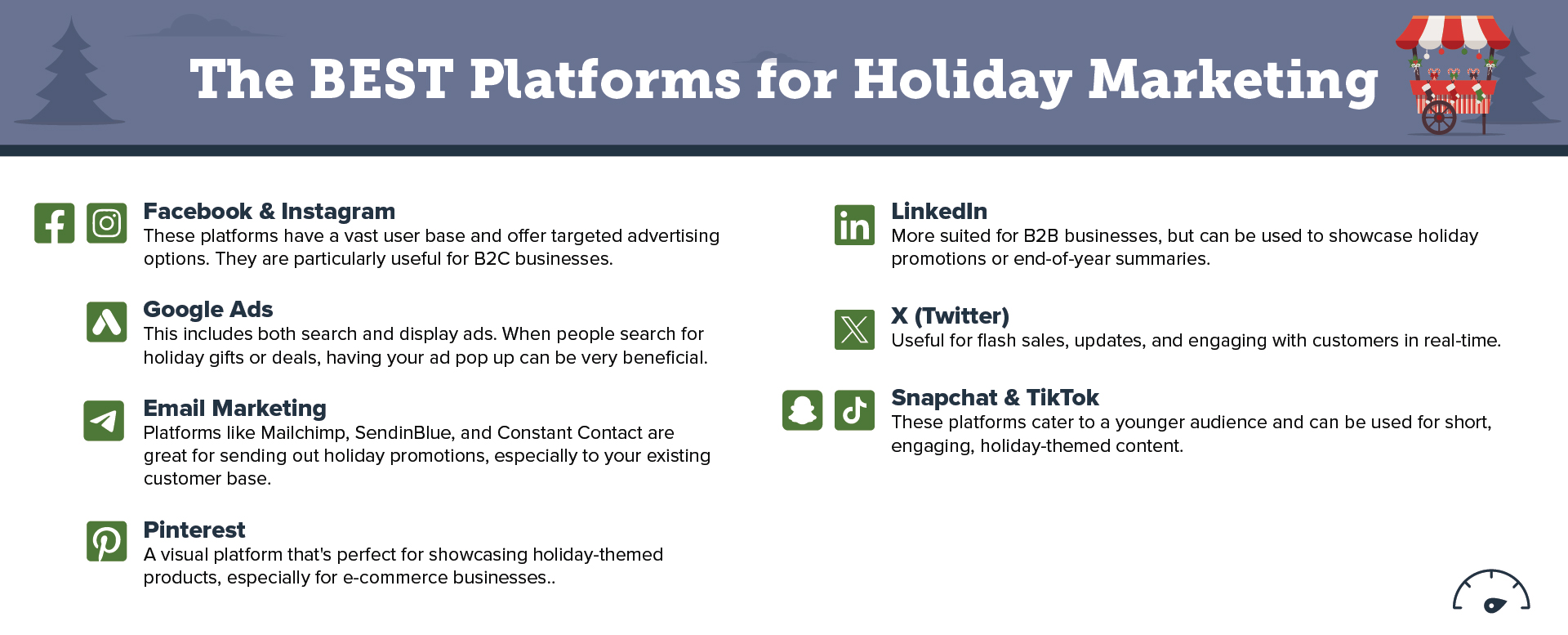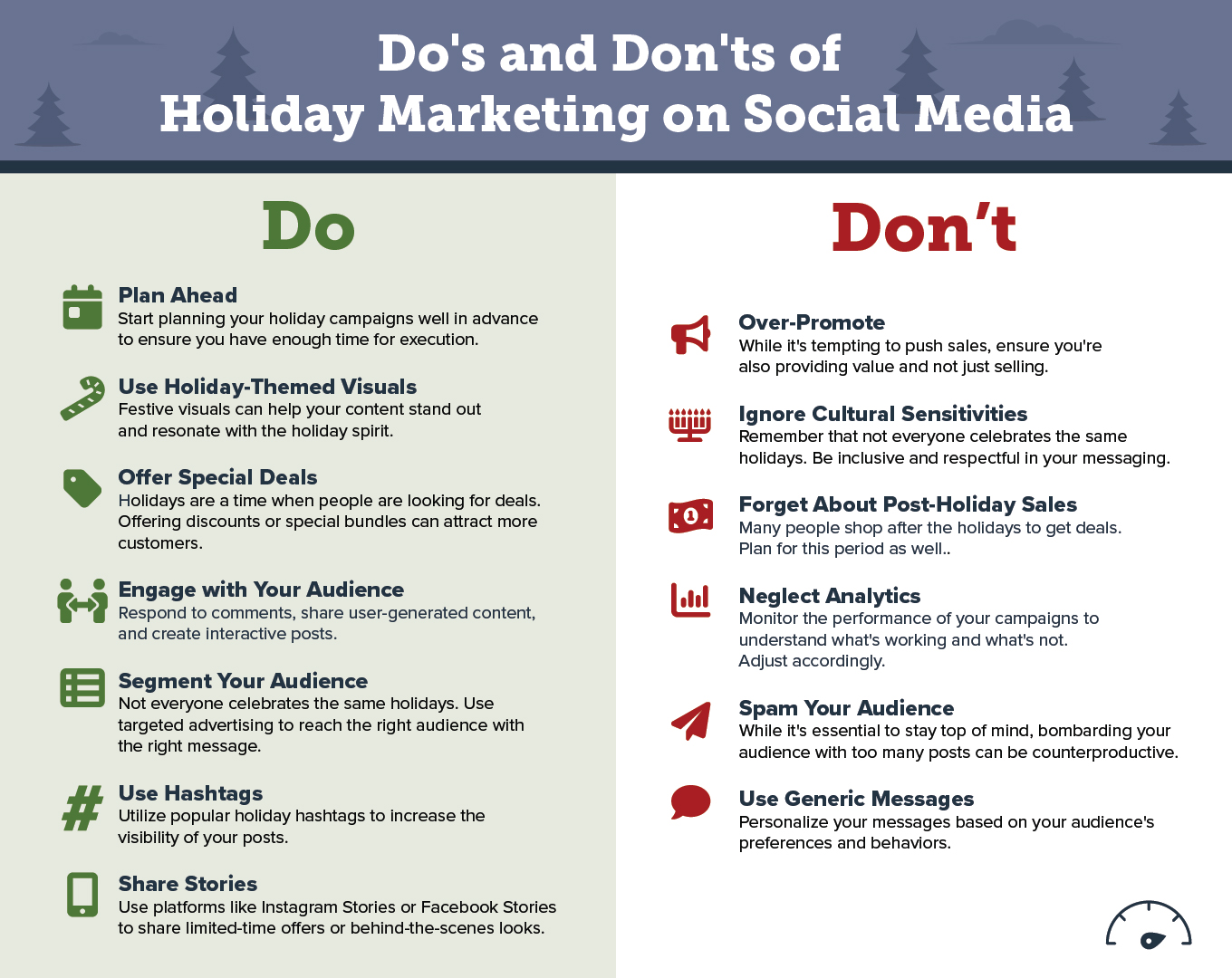The holidays are a time of excitement, celebration, and fun. For small businesses, these are usually coupled with the promise of more business as consumers shop for holiday gifts and sales. Here are some tips for boosting your holiday marketing strategy to get the most out of the season.
- Why Is Holiday Marketing Important?
- Holiday Marketing Tips for Small Businesses
- Holiday Marketing FAQs
Why Is Holiday Marketing Important?
Holiday marketing is important for small businesses because it gives you unique opportunities to reach motivated consumers, convert new buyers, and build on relationships with your existing audience.
End-of-year holiday sales have increased to nearly $1 trillion in the last three years, with consumers spending just under $1,500 on average from October to December on gifts, travel, and entertainment. Because many are actively and urgently looking for festive products and better deals on services at this time, your business needs to be capitalizing on this increased demand.
If done well, holiday marketing campaigns do more than attract new customers. They also help your existing customers feel appreciated and emotionally connected to your brand. Effective holiday marketing keeps you top of mind and builds long-term trust, helping with your customer retention and referrals.
Holiday Marketing Tips for Small Businesses
Whether your small business is putting together its first or hundredth holiday marketing strategy, here’s everything you should and shouldn’t do to make it a success.
Do Put Your Customers First
Now more than ever, customers want brands to be authentic and are better at sensing when your business is using the season to pump sales instead of actually getting into the holiday spirit. Just compare the reception of REI’s “Opt Outside” campaign to how big box retailers handled Thanksgiving and Black Friday over the last few years.
While companies like Walmart, Target, and Best Buy faced backlash for keeping their workers away from their families just to stay open later, consumers applauded REI for closing its stores and paying its employees to spend time with loved ones in nature.
If that teaches us anything, it’s that pure motives and holiday-focused goals—like more quality family time, gratitude, and helping others—will always pay off in your business’ holiday marketing strategy. We recommend embracing the festive spirit and highlighting what makes this time of year so special.
Because the season is brief, people are hungry for unique experiences and the traditions that it brings. So, infuse your messaging with a sense of urgency and aim to create unforgettable moments your customers will cherish far beyond the season with themed events, exclusive discounts, complimentary gifts, or handwritten cards to show your appreciation.
Don’t Create False Urgency
Just like you, almost all of your competitors will also be advertising and offering promotions during the holidays. While it’s important to stay competitive, make sure you don’t inadvertently overwhelm your audience and contribute to ad fatigue.
Don’t bombard customers with too many emails or social media posts to the point that they feel like you just value them for their wallets. While a bit of urgency is good, flooding inboxes and feeds with too many limited-time offers, flash sales, or constant reminders of scarcity will just lead to people tuning out or becoming skeptical of your messaging.
There aren’t any hard rules on how many or how often you should be sending holiday messages, but we recommend starting with the 80/20 principal, which suggests around 80% of your content should be non-promotional and focused on providing value to your audience, while the remaining 20% can be related to seasonal promotions. Typically, that’ll look like no more than one to three holiday emails or social media posts per week.
Do Target the Correct Audience
Many cultures and religions across the world celebrate different holidays in different ways at different times. Even if you’re confident in your audience targeting, it’s not a bad idea to reassess towards the end of the year to be sure you know which holidays and how your customers are celebrating.
Once you’ve nailed down your audience’s preferences, reflect them in your messaging by using the right language (like “Happy Hanukkah” instead of “Merry Christmas” or the generic “Happy Holidays”) and being sensitive to cultural expectations.
Even if unintentional, cultural insensitivity can have major kickback, as seen in 2017 when Cadbury removed “Easter” from their chocolate egg wrapping and the name of their event (the “egg hunt”). While many other products (as well as their website) still mentioned Easter, consumers took this act as a deliberate attempt by the brand to distance from the holiday and stormed Cadbury with complaints.
To avoid these pitfalls, you should keep a detailed content calendar marked with your audience’s important holidays. Audience segmentation, geofencing, and personalization will also help if your audience is multicultural and you’re running different versions of your holiday ads.
Don’t Ignore Holiday Marketing
It might be tempting to minimize the risk of upsetting your audience by avoiding the subject altogether. But if you brush past all holidays, you’re missing out on sales and potentially harming your brand reputation by making customers and their unique cultures feel unacknowledged or unappreciated. Even if you release non-specific holiday greetings, seasonal messaging can make customers feel seen and accepted.
That doesn’t mean you should run headfirst into marketing initiatives for every single holiday to every single customer. Your choices need to align with your business’ ethos. For example, if you’re a women-led business, celebrating International Women’s Day makes sense, but a male-dominated company that puts out a similar campaign will catch more criticism.
On a similar note, make sure your business actually supports the holiday, culture, and people behind it year-round. If you can’t point to past initiatives or explain how your actions fit with your mission, consumers will think you’re just trying to profit from the holiday, as is the case with rainbow capitalism—when companies release LGBTQIA+ marketing and branding during Pride Month, but don’t comment on related social issues any other time of year. These businesses end up looking fake.
That said, not all of your customers will want to see holiday marketing. While holidays are often a time of joy for many, they also spark grief and negative emotions for others. Your small business will want to be sensitive to this by allowing your customers to opt in or out of holiday marketing reminders. You can do this in a preference center on your website when customers sign up or have it as an option in the emails and ads you send out.
Do Stick With Your Brand Identity
You should get into the spirit of the holidays, but not at the expense of your usual branding. Follow your tone, design, and style rules first, then worry about adding in holiday language. If your content is usually playful and funny, try some holiday jokes in your ads. If you have more serious messaging, stay formal with simple holiday well wishes.
The identity of the holiday matters too. Some brands intentionally craft extreme (sometimes inappropriate) holiday messaging that doesn’t match the vibe of the season for shock value. Though this can be effective at getting noticed and driving engagement short-term, the attention often isn’t positive or helpful for your reputation long-term.
For example, Bloomingdale’s marketing team released an ad in 2015 with the copy “Spike your best friend’s eggnog when they’re not looking” alongside a man staring at a woman laughing next to him. To say it was in bad taste would be an understatement. Customers immediately and heavily criticized the brand for the offensive ad that wasn’t at all in line with the holidays. Avoid making the same mistake by keeping ads genuine and staying within the bounds of the holiday’s meaning, rather than trying to shock.
Don’t Focus All Your Efforts on Organic Marketing
The digital ad spend from October to January in the U.S. increases to around $57 billion, a huge spike compared to the rest of the year. So even though organic marketing is a great focus for most of the year, the holidays are a popular time for businesses to expand their paid marketing strategy to get in front of more people and compete with similar businesses.
Paid social is one of the best and easiest ways to break into paid advertising. It uses the social media content you’re already producing for your organic marketing and boosts it, so there’s not too much additional work involved. Paid search is another great form of paid advertising for beginners that lets you turn your seasonal landing pages into boosted search engine results to make your holiday campaign more visible.
Do Use Multiple Marketing Channels
Even if you haven’t used different channels in your marketing strategy before, the holidays are the perfect time to experiment online. By diversifying your strategy across social media, email marketing, local search, and content marketing, you’re giving yourself more chances of being discovered by consumers.
After researching which channels your target audience frequents during the holidays, craft campaigns tailored to these platforms. Some common platforms to start with are Google Business Profile, Instagram, Facebook, TikTok, email, and other businesses’ websites. Hurrdat’s Social Media Director, Allie Gritt, suggests the following platforms for holiday marketing:

Keep marketing materials simple, eye-catching, and quickly digestible. Short-form videos, value-led content, and mobile-optimized text are currently the most popular trends among marketers to achieve results over the holidays and beyond.
Don’t Forget to Optimize Your Website
Your holiday marketing campaigns mean nothing if your website isn’t properly optimized. After all, your digital ads should be sending users to your website—hopefully holiday-specific landing pages—to convert them into paying customers.
Landing pages are super streamlined webpages with one topic and one goal—to get users to take some type of action, whether that’s making a purchase, using a discount code, or visiting your physical location. You should create a holiday-specific landing page for all of your promotions, gifts, and donation opportunities. Your landing pages should have optimized SEO titles, meta descriptions, and headers with holiday-specific keywords to help them rank higher, making them more visible to customers.
Besides landing page best practices, you also need to follow general website guidelines. If your site is confusing to navigate, your page load times are too slow, or you have too many broken links, people are more likely to leave and find another business with a better user experience. Display your holiday shopping promotions on your homepage and link off to more in-depth pages about the promotion. Also make sure your site can accommodate holiday traffic without slowing down. Finally, if you haven’t already, optimize your website for mobile since 79% of consumers are purchasing on their mobile phones, and a bad mobile interface can scare them away.
Do Contribute to Your Local Community
Want to expand your reach and connect with more people in your area? You’ll probably find that there are plenty of holiday-related local events where you can set up a booth and sell your products or advertise your promotions. You could even plan your own or partner with a local cause to support your local SEO strategy over the holidays.
Giving back is another option. Around specific holidays, you can contribute some of your proceeds to a local charity, sponsor a toy drive or canned food drive for families in need, or give customers a chance to donate to a cause of their choice. This isn’t limited to holidays in November and December, either.
- If you’re a small mortgage lender that specializes in VA loans, you might donate to the Department of Veterans Affairs or local VU hospitals on Veterans Day.
- If you’re a black-owned clothing boutique, you might host a clothing drive or special event on Juneteenth.
- If you’re a local yoga and meditation studio, you might offer discounted memberships during Mental Health Awareness month.
For whatever you decide to do, do it proudly and openly. Some business owners want to keep donations a secret so they aren’t seen as boastful or having ulterior motives. That said, consumers generally appreciate authenticity and transparency, making charitable giving that aligns with your values a really strong small business marketing strategy.
Don’t Wait Until the Last Minute
Holiday advertising seems to start earlier and earlier every year, and your planning should reflect this. When you release your holiday marketing ahead of time, you take some pressure off your company during peak season, give your content more time to perform, and ensure your customers aren’t too focused on holiday celebrations to see your promotions.
If you’ve released holiday marketing campaigns before, start by reviewing them to see what did and didn’t work in past years. Decide which products and services you want to promote, and discuss what methods and messaging will be best for your campaigns. Then, craft a holiday-specific marketing plan with detailed goals to achieve throughout the season.
After you’ve thought through your holiday marketing strategy, schedule your posts and marketing materials to be sent out in advance. Email and social media scheduling tools are perfect for this, as they take more of the urgent planning off your hands by posting and sending messages for you.
If you’re sending press releases about your events to local news stations, they need ample time to get your story ready to share. For ads, you’ll want to post about promotions or sales events at least a week in advance so they have time to circulate and so your customers have time to plan.
Do Get Help If You Need It
Often, it’s not realistic for one-person teams and small businesses with limited resources to take on the extra time, effort, and holiday traffic solo. Now more than ever, it’s good to have some help executing your small business marketing strategy.
Holiday advertising is also hard to get right without any outside input or industry knowledge. So, you might conduct market research beforehand, hire a test group, or simply run the campaign past your staff to catch any technical and cultural errors.
If you’re still on the fence about hiring help, here’s what you should be asking yourself:
- What are my marketing goals? Based on my goals, do I have the necessary expertise to achieve them?
- How much time and how many people does my company have to create and distribute our holiday advertising?
- Have I considered alternatives like automation tools or seasonal staff if full-scale options aren’t available?
- What is my budget?
- What are the potential returns on investment?
Holiday Marketing FAQs
How Can I Ensure I Don’t Offend Anyone With My Holiday Marketing?
It’s impossible to be completely sure that you won’t make any mistakes when crafting a holiday marketing strategy, but there are a few ways you can avoid making large blunders. You can start by surveying your current customers to see what holidays they celebrate and research those well to confirm your promotions won’t be committing any faux pas.
If your customers are very diverse and celebrate a wide variety of holidays throughout the year, you could also create a calendar of holidays to reference as you send out marketing materials, as well as segment your audience by the holidays they do celebrate, and personalizing campaigns based on these groups.
For example, some holidays—like Ramadan–are celebrated with daily fasting, so you could avoid promoting new food products too much during that time. During gift-based holidays, promote your products all you want, but during holidays when gifts aren’t the focus (like Thanksgiving or Memorial Day), stick to more customer appreciation campaigns.
How Can I Conduct Testing For My Holiday Marketing Campaign?
The best way to conduct testing for your holiday marketing strategies is by looking back at past years’ campaigns for both your own business and your competitors! You can find competitor campaigns directly on their social media profiles or with competitor spy tools like Semrush.
The great thing about holidays is that celebrating doesn’t vary too much year to year, so taking insights from past performance is a good way to see what you should do differently in this year’s campaign. Just be sure to revisit any automated campaigns if there are major disruptions in the world (like natural disasters or global pandemics) that could impact your messaging.
If you plan far enough in advance, you can also conduct testing by surveying your audience and gauging their reaction to different sentiments and marketing tactics. Getting their opinion will help you frame the coming year’s campaign.
What If My Business Doesn’t Have Any Holiday-Related Products or Services?
You don’t need to carry holiday-specific products to run successful holiday marketing campaigns! If you’re struggling with finding a small business marketing strategy that fits your products and services for the holidays, focus more on the message and imagery than the product.
Take Lexus, for example. Selling cars doesn’t scream “holidays,” but most years, you can expect to see the classic big red bow on top of a car driving through the snow. It invokes the idea of the holiday season, while staying true to the product.
Are There Any Best Practices for Holiday Advertising on Social Media?
Yes, Hurrdat’s Social Media Director, Allie Gritt, says, “The seven most important social media best practices a small business owner can follow during holiday marketing are to:
- Plan Ahead
- Use Holiday-Themed Visuals
- Offer Special Deals
- Engage with Your Audience
- Segment Your Audience
- Use Hashtags
- Share Stories
And you should never:
- Over-Promote
- Ignore Cultural Sensitivities
- Forget About Post-Holiday Sales
- Neglect Analytics
- Spam Your Audience
- Use Generic Messages”

Want to nail your holiday marketing campaigns this year? Local Search Fuel by Hurrdat is designed to help small businesses get the most out of their marketing strategies to increase visibility and attract more customers. Get started today!

Stefanie Vanderbeek
Stefanie Vanderbeek is a content strategist and writer who specializes in long-form digital content and website SEO optimization. Stefanie earned her Bachelor of Journalism from the University of Nebraska-Lincoln in Advertising and Public Relations in 2021. In her free time, you can find Stefanie reading, deep diving into video game lore, singing in her professional vocal group, or traveling the world!
